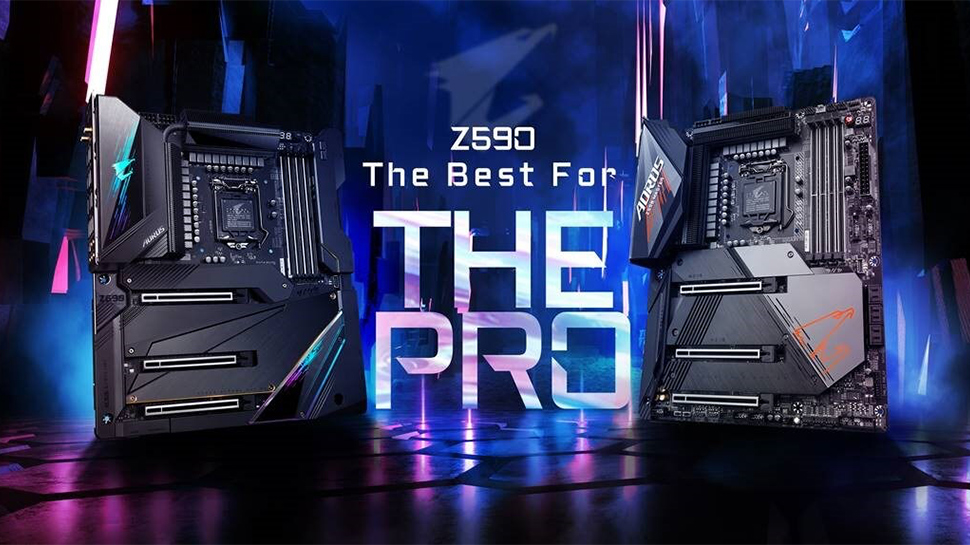Gigabyte presented nine Intel Z590-based Aorus-branded motherboards at CES earlier this month, but didn’t actually showcase perhaps the most ambitious model in the lineup: The Z590 Aorus Tachyon, which can deliver up to an almost-ridiculous 1300A of power to Intel’s upcoming Rocket Lake chips. For reference, most flagship motherboards top out around 1000A.
If you’re looking for the ultimate in overclocking performance, it all starts with power delivery, and the Tachyon comes well-equipped for the task – just be sure to bring either extreme cooling, like LN2, or one of the new sub-ambient coolers, like the EKWB QuantumX Delta TEC or Cooler Master MasterLiquid ML360 Sub-Zero.
Tachyon is a hypothetical particle that travels faster than light. As the motherboard’s name suggests, the platform is aimed at the most extreme overclockers and has several features designed for professional overclockers.
The motherboard features a 10+2+1-phase (Vcore+GT+VCCSA) digital voltage regulating module based on the Renesas ISL69269 PWM controller with phases rated for up to 100 Amperes each, according to ChipHell. But as photos of the board published by Overclocking.com indicate, a VRM that can deliver up to 1300A to Intel’s 11th Generation Core ‘Rocket Lake-S’ CPU is certainly just one of the features meant to maximize overclocking potential of the Z590 Aorus Tachyon.
The Gigabyte Z590 Aorus Tachyon comes in the E-ATX form-factor that allowed the manufacturer to ensure the best possible routing with thick traces, enough space between traces, smooth angles, and other aspects to ensure signal integrity and clean power. As a bonus (in this case), the large form-factor allowed Gigabyte to install overclock-specific elements onto the motherboard (e.g., a range of manual hardware overclocking buttons).
The Z590 Aorus Tachyon motherboard has only two slots for DDR4 memory, which was done to maximize DRAM overclocking potential by simplifying signaling topology and delivering cleaner power to memory modules. Of course, two memory slots limit the motherboard’s maximum memory capacity to 64GB, but this is a fair tradeoff if you’re looking to do some heavy memory overclocking.
Like most platforms for overclockers, Gigabyte’s Tachyon features two BIOS ICs: one for overclocking experiments and another for regular usage. But in the case of the Z590 Aorus Tachyon, some BIOS settings can be controlled manually using six switches. One knob can switch between BIOSes, and another two switches are assigned for LN2 operation, but it is unclear what the rest three do. Additionally, the Z590 Aorus Tachyon motherboard has hardware A/B and +/- buttons to alter the CPU multiplier and control BCLK.
The platform also has a traditional debug LED able to display a two-symbol code. For more precise control of overvoltages, there is an onboard voltage measurement module to conveniently probe voltages with a multimeter.
Other notable features important for enthusiasts include four PCIe x16 slots, pre-installed radiators for M.2 SSDs, Gigabyte’s proprietary ‘Solid Pin’ ATX power connector, and two EPS power connectors.
Gigabyte classifies its Z590 Aorus Tachyon as a successor of its rather legendary SOC (SuperOverClocking) series motherboards from the mid-2010s.
Gigabyte doesn’t list its Z590 Aorus Tachyon motherboard on its website among other Intel Z590-powered platforms yet, which may indicate that either the company has not finalized the feature set and design of the product, or it just doesn’t want to share them before the board hits store shelves. Anyhow, right now, we have no idea when the Z590 Aorus Tachyon is set to be available and how much Gigabyte plans to charge for it.
